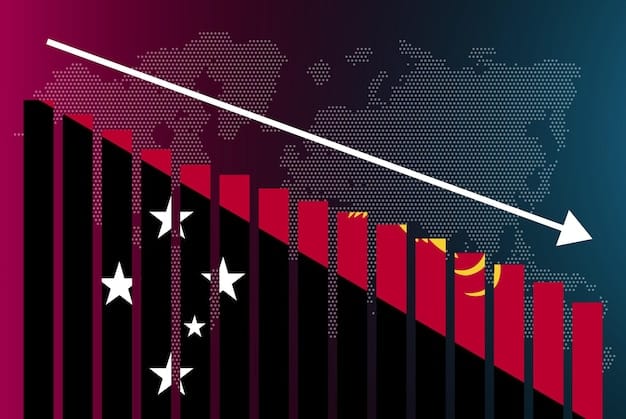Understanding the Surge: Remittances to Peru from the US Increase by 15%

Understanding the 15% Increase in Remittances to Peru from the US in the Last 3 Months involves analyzing economic factors, the Peruvian-American community’s financial behavior, and global financial trends affecting money transfers.
The recent surge in remittances to Peru from the US has caught the attention of economists and the Peruvian-American community alike. Understanding the 15% Increase in Remittances to Peru from the US in the Last 3 Months requires a deeper dive into the various factors at play. Let’s explore why this is happening and what it means.
Why are Remittances to Peru from the US Important?
Remittances represent a significant source of income for many families in Peru, often used for basic necessities like food, healthcare, and education. Understanding their fluctuations is critical because they directly impact the country’s economy and the well-being of its citizens. These transfers represent more than just money; they are lifelines connecting families across borders.
Economic Impact of Remittances
When remittances increase, there’s a ripple effect throughout the Peruvian economy. Families have more disposable income, leading to increased spending and investment. This boosts local businesses and stimulates economic growth. An increase in remittances can also improve Peru’s balance of payments and reduce its reliance on external debt.
- Improved Living Standards: Increased income helps families afford better housing, healthcare, and education.
- Stimulated Local Economy: Higher consumer spending supports local businesses and job creation.
- Reduced Poverty: Remittances can lift families out of poverty, providing a financial safety net.
Conversely, a decrease in remittances can have adverse effects, leading to economic hardship for families and hindering overall development. Therefore, the stability and growth of remittance flows are vital for Peru’s economic prosperity.
In summary, understanding the significance of remittances involves recognizing their profound influence on individual households as well as the broader economic landscape of Peru. Monitoring these financial flows offers insights into the well-being and resilience of Peruvian communities.
Key Factors Driving the 15% Increase
Several factors contributed to the recent 15% surge in remittances. Increased economic activity in the US, changes in immigration policies, and specific events in Peru all play a role. Let’s examine these factors in detail to understand the driving forces behind this trend.

US Economic Growth
The US economy has shown significant growth in recent months, leading to increased employment and higher wages for many Peruvian-Americans. This improved financial stability enables them to send more money home to their families in Peru. Economic indicators such as GDP growth, unemployment rates, and wage increases support this connection.
Furthermore, certain sectors in the US, like technology and healthcare, have been particularly robust, offering better job opportunities and higher incomes for Peruvian immigrants. These economic gains translate directly into increased remittances sent to Peru.
Changes in Immigration Policies
Immigration policies can influence remittance flows in various ways. Changes that make it easier for Peruvian immigrants to work and live in the US can lead to increased remittances. Conversely, stricter policies can deter migration and potentially reduce the amount of money sent home.
- Work Permits and Visas: Easier access to work permits and visas allows more Peruvians to work legally in the US.
- Deportation Policies: Increased deportations can disrupt remittance flows as individuals return to Peru.
- Immigrant Support Programs: Programs that support immigrants in the US can indirectly increase remittance flows.
Understanding these policy changes is crucial for predicting future trends in remittances. Governments and organizations must consider these factors when formulating economic and social strategies.
Concluding this section, various intertwined elements, including the economic landscape in the US and the immigration policies in force, synergistically foster a noticeable escalation in the flow of remittances directed towards Peru. Comprehending these pivotal factors is paramount to foreseeing and strategically addressing the ramifications of this financial influx.
The Role of the Peruvian-American Community
The Peruvian-American community serves as the primary conduit for remittances flowing from the US to Peru. This community’s financial behavior, demographics, and cultural values significantly impact the volume and frequency of these transfers. Let’s delve into the dynamics of this vital connection.
Demographics and Financial Behavior
Understanding the demographics of the Peruvian-American community is essential for analyzing remittance patterns. Key factors include age, education level, employment status, and income levels. These demographic characteristics influence the financial capacity and willingness of individuals to send money home.
For example, a higher proportion of employed and higher-income individuals within the community typically leads to increased remittance flows. Additionally, cultural values and family obligations play a significant role in motivating individuals to support their relatives in Peru.

Impact of Cultural Values
Cultural values such as family responsibility, loyalty, and a strong sense of community drive many Peruvian-Americans to send money home regularly. These values reinforce the importance of supporting relatives in Peru, particularly during times of economic hardship or personal need.
Moreover, cultural events, celebrations, and traditions often serve as reminders of the importance of family ties and the need to provide financial assistance. These cultural influences perpetuate the cycle of remittances and strengthen the bond between the Peruvian diaspora and their homeland.
In conclusion, the Peruvian-American community forms the backbone of the remittance corridor, driven by demographic factors and deeply rooted cultural values. Recognizing this pivotal role and tailoring programs to support this community can further enhance the positive impact of remittances on Peru’s development.
How Technology Facilitates Remittances
Technological advancements have revolutionized the way remittances are sent and received, making the process faster, cheaper, and more convenient. Online platforms, mobile apps, and digital wallets have streamlined money transfers, enabling individuals to send money home with ease. Let’s explore how these technologies are transforming the remittance landscape.
Online Platforms and Mobile Apps
Online platforms and mobile apps offer a convenient alternative to traditional money transfer services. These platforms typically provide lower fees, faster transaction times, and greater transparency. Users can send money from their computers or smartphones, eliminating the need to visit a physical location.
Companies like Xoom, Remitly, and WorldRemit have gained popularity among Peruvian-Americans due to their user-friendly interfaces, competitive exchange rates, and secure transfer methods. These platforms also offer features such as real-time tracking and multilingual support, enhancing the overall user experience.
- Lower Fees: Reduced transaction costs compared to traditional methods.
- Faster Transfers: Money arrives in Peru within minutes or hours.
- Convenience: Send money from anywhere with an internet connection.
The adoption of these technologies has significantly increased the volume of remittances sent to Peru, contributing to the recent surge in financial flows. As more individuals embrace digital solutions, the trend is likely to continue.
The Role of Digital Wallets
Digital wallets are another technological innovation that has facilitated remittances to Peru. These virtual wallets allow users to store, send, and receive money electronically. They offer a secure and convenient way to manage funds, particularly in areas where traditional banking services are limited.
In Peru, digital wallets like Yape and Plin have gained traction, enabling recipients to receive remittances directly on their smartphones. This eliminates the need to visit a bank or money transfer agent, saving time and reducing costs. The increasing popularity of digital wallets is further streamlining the remittance process.
Concluding this examination, digital platforms, alongside smartphone applications and virtual wallets, have engendered a substantial shift in the manner remittances are transacted, rendering the procedure more expeditious, economical, and user-friendly. The continuous strides in technology are poised to further transform the panorama of remittances, fostering amplified economic interconnectedness spanning across national borders.
Potential Challenges and Future Outlook
Despite the positive impact of increased remittances, several challenges could affect future flows. Economic downturns in the US, policy changes, and geopolitical events could all influence the volume of money sent to Peru. Understanding these potential risks is crucial for anticipating future trends.
Economic Downturns in the US
Economic recessions or slowdowns in the US can lead to job losses and reduced income for Peruvian-Americans, impacting their ability to send money home. During times of economic hardship, individuals may prioritize their own financial needs over supporting relatives in Peru. This can result in a decrease in remittance flows, affecting the Peruvian economy.
Monitoring key economic indicators in the US, such as GDP growth, unemployment rates, and wage levels, is essential for predicting potential fluctuations in remittance flows. Governments and organizations can implement policies to mitigate the impact of economic downturns and support remittance-dependent families.
- Unemployment Rates: Higher unemployment reduces remittance capacity.
- Wage Stagnation: Limited wage growth restricts disposable income for remittances.
- Recessions: Economic downturns can significantly decrease remittance flows.
Therefore, understanding the economic climate in the US is crucial for forecasting and addressing potential challenges to remittance flows.
Geopolitical Factors
Geopolitical events, such as political instability, natural disasters, or health crises, can also disrupt remittance flows. These events can affect the ability of individuals to send money home or the capacity of recipients to receive it. For example, a major earthquake or political upheaval in Peru could disrupt financial systems and hinder remittance transfers.
Furthermore, changes in international relations or trade agreements can impact economic conditions in both the US and Peru, affecting remittance patterns. It is important to monitor these geopolitical factors and implement measures to ensure the continuity of remittance flows during times of crisis.
In conclusion, being aware of the prospective adversities, encompassing economic contractions and geopolitical developments, equips us to foresee and strategically address the trajectory of remittance flows. Through diligent vigilance and proactive approaches, it is feasible to ameliorate the repercussions of these factors and assure the sustained provision of monetary support to families residing in Peru.
Strategies to Maximize the Impact of Remittances
To fully harness the benefits of increased remittances, it is crucial to implement strategies that maximize their impact on Peru’s development. These strategies include promoting financial literacy, supporting entrepreneurship, and fostering sustainable development initiatives. Let’s explore how these approaches can enhance the positive effects of remittance flows.
Promoting Financial Literacy
Financial literacy programs can empower remittance recipients to manage their money effectively and make informed financial decisions. These programs provide individuals with the knowledge and skills to budget, save, invest, and access financial services. By improving financial literacy, remittance recipients can use their money more strategically and build long-term financial stability.
Governments, NGOs, and financial institutions can collaborate to offer financial literacy training, workshops, and resources to remittance-dependent communities. These initiatives can help individuals make the most of their remittance income and improve their overall financial well-being.
In summary, fostering financial proficiency among beneficiaries of remittances empowers them to optimally allocate their resources and cultivate enduring fiscal resilience. The execution of these strategies can substantially heighten the constructive influence of remittances on the progress and prosperity of Peru.
| Key Point | Brief Description |
|---|---|
| 📈 Economic Growth | US economic growth boosts Peruvian-American incomes, leading to more remittances. |
| 📱 Technology | Online platforms and digital wallets make sending money faster and cheaper. |
| 👨👩👧👦 Community | Strong cultural values and family ties drive the Peruvian-American community to send money home. |
| ⚠️ Potential Risks | Economic downturns and geopolitical events can disrupt remittance flows. |
Frequently Asked Questions
▼
Remittances are money transfers sent by individuals working abroad to their families back home. For Peru, these inflows are crucial as they support household incomes and national economic stability.
▼
The key factors include economic growth in the US, easier access to online transfer platforms, and a strong commitment from the Peruvian-American community to support their families.
▼
Digital platforms like Remitly and WorldRemit offer lower fees and faster transfers, making it easier for people to send money. This convenience greatly contributes to increased remittance volumes.
▼
Potential challenges include economic recessions in the US, changes in immigration policies, and geopolitical instability, all of which can reduce the ability or willingness to send money.
▼
Peru can maximize benefits by promoting financial literacy among recipients and supporting entrepreneurship initiatives, enabling families to use the remittances not just for immediate needs but also for long-term investment.
Conclusion
Understanding the 15% Increase in Remittances to Peru from the US in the Last 3 Months requires a comprehensive analysis of various economic, technological, and social factors. The Peruvian-American community’s dedication, combined with advancements in money transfer technology, has significantly contributed to this surge. By addressing potential challenges and implementing strategies to maximize the impact of remittances, Peru can further leverage these flows for sustainable development and improved quality of life for its citizens.





